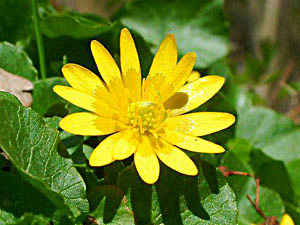
medicinal herbs
Lesser Celandine
Ranunculus ficaria

Herb: Lesser Celandine
Latin name: Ranunculus ficaria
Synonyms: Ficaria ranunculoides, Ficaria verna
Family: Ranunculaceae (Buttercup Family)
Medicinal use of Lesser Celandine:
Lesser celandine has been used for thousands of years in the treatment of haemorrhoids and ulcers. It is not recommended for internal use because it contains several toxic components. The whole plant, including the roots, is astringent. It is harvested when flowering in March and April and dried for later use. It is widely used as a remedy for piles and is considered almost a specific. An infusion can be taken internally or it can be made into an ointment and used externally. It is also applied externally to perineal damage after childbirth. Some caution is advised because it can cause irritation to sensitive skins.Description of the plant:

Plant:
Perennial
Height:
20 cm(7 3/4 inch)

Flowering:
Marchto May
Habitat of the herb:
Woods, scrub, meadows, by streams etc, avoiding acid soils.Edible parts of Lesser Celandine:
Young leaves in spring - raw or cooked as a potherb. The first leaves in spring make an excellent salad. The leaves, stalks and buds can be used like spinach, whilst the blanched stems are also eaten. The leaves turn poisonous as the fruit matures. Caution is advised regarding the use of this plant for food, see the notes above on toxicity. Bulbils - cooked and used as a vegetable. The bulbils are formed at the leaf axils and also at the roots. Caution is advised, see the notes above on toxicity. The flower buds make a good substitute for capers.Other uses of the herb:
The flower petals are an effective tooth cleaner. ( See notes at top of the page before using the petals) The plant often forms dense carpets when grown in the shade and can therefore be used as a ground cover though they die down in early summer. This should be done with some caution, however, since the plant can easily become an unwanted and aggressive weed in the garden.Propagation of Lesser Celandine:
Seed - sow spring in a cold frame. This species doesn"t really need any help from us. Division in spring.Cultivation of the herb:
Woods, scrub, meadows, by streams etc, avoiding acid soils.Known hazards of Ranunculus ficaria:
All parts of the plant are poisonous. The toxins are unstable and of low toxicity, they are easily destroyed by heat or by drying. The sap can cause irritation to the skin.Plant information taken from the Plants For A Future.
